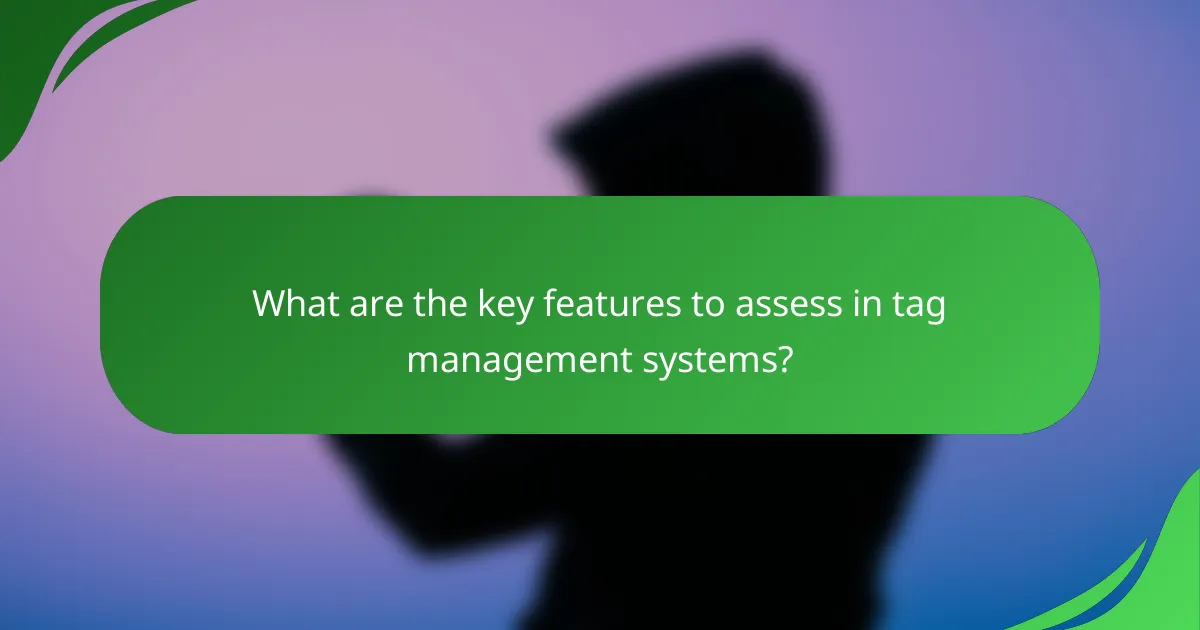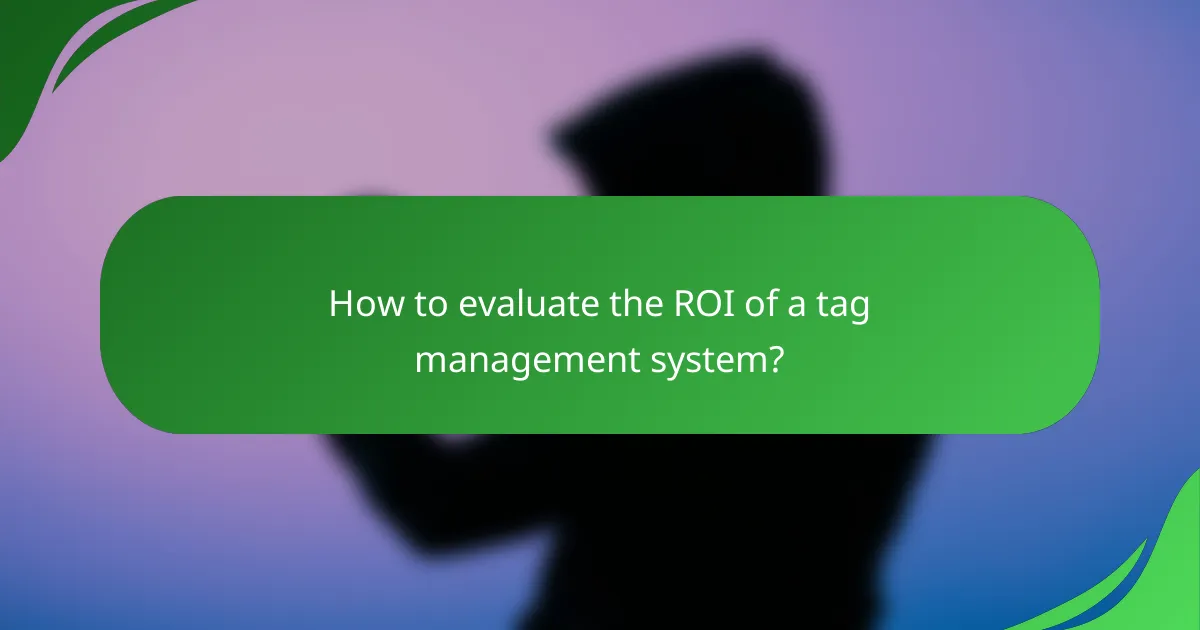Integrating a tag management system (TMS) into your tech stack is essential for optimizing data collection and analytics. By selecting the right TMS, such as Google Tag Manager or Adobe Experience Platform Launch, businesses can streamline their tracking processes while ensuring compliance with local regulations. Key factors to consider include user interface, integration capabilities, and real-time data processing, all of which significantly enhance marketing effectiveness.

What are the best tag management systems for Canadian businesses?
For Canadian businesses, the best tag management systems (TMS) include Google Tag Manager, Adobe Experience Platform Launch, Tealium iQ Tag Management, Ensighten, and Segment. These platforms offer robust features that cater to various needs, such as ease of use, integration capabilities, and compliance with local regulations.
Google Tag Manager
Google Tag Manager (GTM) is a widely used TMS that simplifies the process of managing marketing tags without extensive coding. It allows users to quickly deploy and update tags for tracking and analytics, making it ideal for businesses looking to enhance their digital marketing efforts.
GTM supports various integrations with Google Analytics, AdWords, and third-party tools, enabling seamless data collection. Canadian businesses benefit from its user-friendly interface and extensive documentation, which help in navigating the platform effectively.
Adobe Experience Platform Launch
Adobe Experience Platform Launch is a powerful TMS designed for enterprises that require advanced capabilities. It offers a flexible architecture that allows for custom integrations and the ability to manage multiple data sources efficiently.
This platform is particularly beneficial for businesses already using Adobe’s suite of marketing tools, as it provides deep integration with Adobe Analytics and Adobe Audience Manager. Canadian companies should consider its scalability and robust features when evaluating their tag management needs.
Tealium iQ Tag Management
Tealium iQ Tag Management is known for its comprehensive data management capabilities. It enables businesses to unify their customer data across various touchpoints, enhancing the accuracy of marketing insights.
Tealium’s real-time data collection and audience segmentation features make it a strong choice for Canadian businesses looking to optimize their marketing strategies. The platform’s extensive library of integrations ensures compatibility with numerous third-party tools, facilitating a seamless user experience.
Ensighten
Ensighten focuses on enterprise-level tag management, providing advanced security and compliance features. It is particularly useful for businesses that handle sensitive customer data and need to adhere to strict privacy regulations.
With Ensighten, Canadian businesses can manage their tags while ensuring compliance with local laws, such as the Personal Information Protection and Electronic Documents Act (PIPEDA). Its robust analytics capabilities also help in making data-driven decisions.
Segment
Segment is a customer data platform that includes tag management as part of its offering. It allows businesses to collect, unify, and activate customer data across multiple channels, making it a versatile choice for Canadian companies.
Segment’s ability to integrate with various marketing tools and its focus on data governance make it an attractive option. Businesses can streamline their data collection processes while ensuring they remain compliant with Canadian regulations regarding data privacy.

How to integrate a tag management system into your tech stack?
Integrating a tag management system (TMS) into your tech stack involves identifying your tagging requirements, selecting an appropriate TMS, and implementing it effectively. This process streamlines the management of tracking codes and scripts, enhancing data collection and analytics capabilities.
Step 1: Define your tagging needs
Start by assessing what data you need to collect and how it will be used. Consider the types of tags required, such as those for analytics, marketing, or conversion tracking. Documenting these needs helps in selecting the right tools and ensures all stakeholders are aligned.
Engage with teams across your organization, including marketing and IT, to understand their requirements. This collaboration can reveal additional tagging needs that may not be immediately obvious, ensuring comprehensive coverage.
Step 2: Choose the right tag management system
Selecting a TMS involves evaluating various options based on features, ease of use, and integration capabilities. Popular systems include Google Tag Manager, Adobe Launch, and Tealium, each offering unique functionalities suited to different business needs.
Consider factors such as pricing, support, and scalability. A system that fits your current needs but can grow with your organization is ideal. Look for user reviews and case studies to gauge effectiveness in similar environments.
Step 3: Implement and test tags
Once you have chosen a TMS, the next step is to implement the tags according to your defined needs. Use the TMS interface to create and manage tags, ensuring they are correctly configured for your data collection goals.
Testing is crucial to ensure that tags fire correctly and collect accurate data. Utilize built-in preview and debug modes in your TMS to verify functionality before going live. Regularly review and update tags as necessary to adapt to changing business requirements or new data needs.

What are the key features to assess in tag management systems?
When evaluating tag management systems (TMS), focus on user interface, integration capabilities, real-time data processing, and version control. These features directly impact how effectively a TMS can streamline your marketing and analytics efforts.
User interface and ease of use
A user-friendly interface is crucial for efficient tag management. Look for systems that offer intuitive navigation, drag-and-drop functionality, and clear labeling of features. This simplicity allows team members, regardless of technical skill, to manage tags effectively.
Consider platforms that provide visual previews of tags and their triggers. This feature helps users understand how changes will affect website performance before implementation, reducing the risk of errors.
Integration capabilities
Integration with existing tools is a vital feature of any tag management system. Ensure the TMS can seamlessly connect with your analytics, CRM, and advertising platforms. Popular integrations include Google Analytics, Facebook Pixel, and various email marketing services.
Evaluate the ease of setting up these integrations. A TMS that supports pre-built connectors can save time and reduce complexity, allowing for quicker deployment of marketing strategies.
Real-time data processing
Real-time data processing enables immediate insights into user behavior and campaign performance. A robust TMS should support real-time updates, allowing marketers to react quickly to data changes without delays.
Look for systems that offer features like instant tag firing and live data previews. This capability ensures that you can monitor the impact of changes as they happen, optimizing your strategies on the fly.
Version control and rollback options
Version control is essential for maintaining the integrity of your tag management process. A good TMS should allow you to save multiple versions of your tags and easily revert to previous versions if needed. This feature minimizes the risk of errors during updates.
Check if the system provides a clear history of changes made, including who made them and when. This transparency helps teams collaborate more effectively and ensures accountability in tag management.

What are the common challenges in tag management system integration?
Common challenges in tag management system integration include ensuring data privacy compliance, addressing tag performance issues, and overcoming team collaboration hurdles. Each of these challenges can impact the effectiveness and efficiency of your tech stack, requiring careful consideration and strategic planning.
Data privacy compliance
Data privacy compliance is critical when integrating a tag management system, especially with regulations like GDPR and CCPA in effect. Organizations must ensure that any data collected through tags adheres to these legal standards, which often require explicit user consent and clear data usage policies.
To navigate compliance, regularly audit your tags and data collection practices. Implementing a robust consent management platform can help manage user permissions effectively, ensuring that your tag management system operates within legal boundaries.
Tag performance issues
Tag performance issues can significantly affect website speed and user experience. Poorly optimized tags may lead to slow loading times, which can result in higher bounce rates and lower conversion rates. It’s essential to monitor the performance of each tag and prioritize those that are critical for analytics and marketing.
Consider using asynchronous loading for tags to minimize their impact on page speed. Regularly review and clean up unused or redundant tags to maintain optimal performance across your tech stack.
Team collaboration hurdles
Team collaboration hurdles often arise when multiple stakeholders are involved in the tag management process. Different teams may have varying priorities and understanding of tag implementation, leading to miscommunication and inefficiencies. Establishing clear roles and responsibilities can help streamline collaboration.
Utilizing project management tools and regular meetings can enhance communication among team members. Documenting processes and creating a centralized knowledge base can also facilitate better collaboration and ensure everyone is aligned on goals and strategies.

How to evaluate the ROI of a tag management system?
Evaluating the ROI of a tag management system (TMS) involves assessing the financial benefits against the costs associated with implementation and maintenance. Key metrics include time savings, improved data accuracy, and enhanced marketing effectiveness, which can translate into increased revenue.
Identify key performance indicators (KPIs)
Start by defining the KPIs that matter most to your organization. Common metrics include website traffic, conversion rates, and customer engagement levels. Establishing clear KPIs allows for a focused evaluation of how a TMS impacts these areas over time.
Calculate implementation and ongoing costs
Consider both the initial setup costs and ongoing expenses related to a TMS. This includes software licensing fees, potential consulting costs, and the time spent by your team on training and management. A comprehensive cost analysis will help you determine the total investment required.
Assess time savings and efficiency gains
One of the primary benefits of a TMS is the reduction in time spent on tag deployment and management. By streamlining these processes, teams can focus on strategic tasks rather than manual updates. Estimate time savings in hours per month and translate this into a financial figure based on employee hourly rates.
Evaluate data accuracy and decision-making
Improved data accuracy is another critical factor in ROI evaluation. A TMS can reduce errors in tracking and reporting, leading to better-informed business decisions. Assess how enhanced data quality can impact marketing strategies and overall business performance.
Consider the impact on marketing effectiveness
A TMS can significantly enhance marketing efforts by enabling more precise targeting and tracking of campaigns. Analyze how improved data collection and reporting can lead to higher conversion rates and increased sales. This can be quantified by comparing pre- and post-implementation performance metrics.



